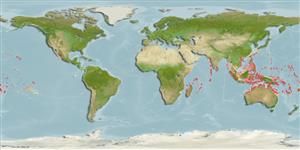Environment: milieu / climate zone / depth range / distribution range
ນິເວດວິທະຍາ
ສັດທະເລ ກ່ຽວກັນຫີນ; ລະດັບຄວາມເລິກ 1 - 15 m (Ref. 86942). Tropical; 32°N - 24°S
Indo-Pacific: East Africa to the Tuamoto Islands, north to southern Japan and the Ogasawara Islands, south to the Great Barrier Reef.
ຂະໜາດ / ນ້ຳໜັກ / Age
Maturity: Lm ? range ? - ? cm
Max length : 5.0 cm TL ຕົວຜູ້/ບໍ່ມີເພດ; (Ref. 2334)
ຄີ (ໜາມ)ແຂງຢູ່ຫຼັງປາ (ທັງໝົດ) : 7 - 8; ຄີຫຼັງຂອງປາ (ຄີອ່ອນ) (ທັງໝົດ) : 12 - 13; ຄີ(ໜາມ) ແຂງຢູ່ຄີກົ້ນປາ
ກຸ່ມປາກະດູກແຂງ
ຄວາມຖີ່ຂອງກຸ່ມຖ່າຍທອດພັນ
ປາທີ່ມີການເຄື່ອນຍ້າຍຈາກທະເລໄປຫານ້ຳຈືດ ແລະນ້ຳຈືດຫາທະເລ
ປາທີ່ມີການເຄື່ອນຍ້າຍຈາກທະເລແລະໄປໄຂ່ຢູ່ນ້ຳຈືດ
ຄີກົ້ນຂອງປາ
ສັດທີ່ມີກະດູກສັນຫັຼງ
ການຖ່າຍທອດທາງກຳມະພັນຈາກພໍ່ແມ່ຫາລູກ: 2; ຄີກົ້ນຂອງປາ: 11 - 12. Uniformly dark species that has smaller, but longer tubercles than C. maculatus and lacks a notch in the dorsal fin.
Facultative air-breathing (Ref. 126274); Found among branches of Stylophora mordax and certain Acropora corals (Ref. 9710). It never ventures outside the confines of the coral head where it swims between the branches foraging for other coral-dwelling types (Ref. 275). Anterolateral glandular groove with venom gland; at least in dorsal-fin spines (Ref. 57406).
Life cycle and mating behavior
ການຈະເລີນເຕັມໄວ | ການສືບພັນ | ການວາງໄຂ່ | ໄຂ່ | ຄວາມດົກຂອງໄຂ່ປາ | ຕົວອ່ອນ
Paxton, J.R., D.F. Hoese, G.R. Allen and J.E. Hanley, 1989. Pisces. Petromyzontidae to Carangidae. Zoological Catalogue of Australia, Vol. 7. Australian Government Publishing Service, Canberra, 665 p. (Ref. 7300)
IUCN Red List Status (Ref. 130435: Version 2024-1)
Human uses
ເຄື່ອງມື
Special reports
Download XML
ແຫຼ່ງອີນເຕີເນັດ
Estimates based on models
Preferred temperature (Ref.
123201): 25.4 - 29.3, mean 28.3 °C (based on 2461 cells).
Phylogenetic diversity index (Ref.
82804): PD
50 = 0.5625 [Uniqueness, from 0.5 = low to 2.0 = high].
Bayesian length-weight: a=0.01995 (0.00906 - 0.04395), b=3.01 (2.83 - 3.19), in cm total length, based on all LWR estimates for this body shape (Ref.
93245).
ຊັ້ນເຂດຮ້ອນ (Ref.
69278): 3.6 ±0.59 se; based on food items.
Fishing Vulnerability (Ref.
59153): Low vulnerability (10 of 100).
Nutrients (Ref.
124155): Calcium = 193 [80, 464] mg/100g; Iron = 0.99 [0.45, 2.18] mg/100g; Protein = 17.6 [15.5, 19.8] %; Omega3 = 0.193 [0.073, 0.594] g/100g; Selenium = 19.6 [8.9, 52.2] μg/100g; VitaminA = 142 [37, 551] μg/100g; Zinc = 1.98 [1.20, 3.14] mg/100g (wet weight);
